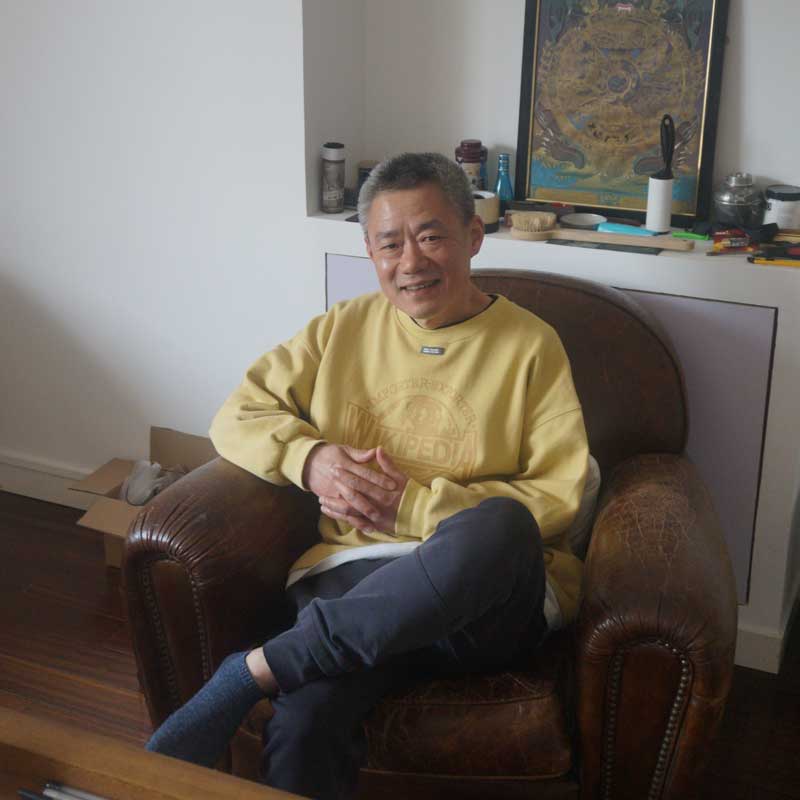1963生于北京,1986毕业于四川美术学院绘画系,后任教于贵州师范大学美术学院,并于1991进修于中央美术学院壁画系,自1999年起,生活创作于北京。
任小林的创作手法融合东方传统与现代主义的视觉语言,通过非线性构图、低饱和色彩、自由生长的笔触与富于节奏感的线条组织,构建出一个处于自然与人造、现实与梦境、感知与精神之间的艺术世界。他拒绝预设整体画面,而是从细节出发,让图像在感知、笔触与思维的并行中生成;画面中常见物象的并置与错位,不是拼贴的戏谑,而是一种神秘的物性召唤与精神感知的结构尝试。
任小林的创作深深植根于东方文化的精神传统,但他并不将“东方性”简化为题材或风格的再现,而是将其转化为一种视觉结构与哲学感知的方式。他从中国传统绘画中汲取线性语言、散点构图与“气”的流动之美,从敦煌、墓室壁画中吸收宗教性,并在对山水、神祇、器物与人物的描绘中,重建人与世界之间的感应关系。他笔下的“东方性”不是静态的文化符号,而是一种游移、未定、生成中的“居间性”空间,是对自然、身体、精神与宇宙秩序的深度沉思。正是在这一意义上,任小林的艺术价值得以凸显:他不是在表现东方,而是在以东方思想方式重新组织世界的观看逻辑。他将传统视觉文化内化为绘画的构成法则,融合现代主义的批判精神与中国文化中的超验意识,使绘画成为一种精神性的构筑过程。他的作品不仅回应了当代社会的精神困境,也为东方文化在当代表达中的延展提供了独特路径,展现出深具文化自觉与形式创新的艺术高度。
Born in Beijing in 1963. He graduated from the Painting Department of the Sichuan Fine Arts Institute in 1986, later teaching at the School of Fine Arts at Guizhou Normal University. In 1991, he pursued further studies in the Mural Department of the Central Academy of Fine Arts. Since 1999, he has been living and working in Beijing.
Ren’s artistic practice fuses Eastern traditions with the visual language of modernism. Through non-linear composition, low-saturation colors, organically evolving brushstrokes, and rhythmic line structures, he constructs an artistic world that resides between nature and artifice, reality and dream, perception and spirit. He rejects the premeditation of an overall image, choosing instead to begin with details, allowing the picture to emerge through a parallel process of perception, brushwork, and thought. The juxtaposition and displacement of objects within his paintings are not playful collages, but a mysterious invocation of material presence and a structural attempt to evoke spiritual perception.
Ren’s work is deeply rooted in the spiritual traditions of Eastern culture. Yet, he does not reduce "Eastern-ness" to the reproduction of subject matter or style. Rather, he transforms it into a mode of visual structure and philosophical perception. Drawing from Chinese classical painting, he adopts the beauty of linear expression, dispersed perspective, and the dynamic flow ofqi (energy). He absorbs religious symbolism from Dunhuang and tomb murals, and through depictions of landscapes, deities, objects, and figures, he reconstructs a responsive relationship between humanity and the world. The “Eastern-ness” in Ren’s paintings is not a static cultural symbol, but a fluid, indeterminate, generativein-between space — a profound meditation on nature, the body, the spirit, and cosmic order. In this sense, Ren’s artistic value becomes especially clear: he is not merely representing the East, but reorganizing the logic of visual perception through an Eastern philosophical lens. By internalizing traditional visual culture as compositional principle, and integrating modernist critique with the transcendental consciousness of Chinese culture, he turns painting into a spiritual process of construction. His work not only responds to the spiritual dilemmas of contemporary society, but also offers a distinctive path for extending Eastern cultural expression in the contemporary moment — revealing a practice that is both culturally self-aware and formally innovative.
作品集 Portfolio:


